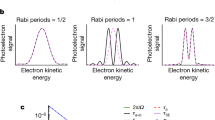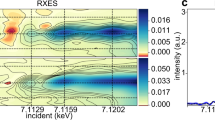Abstract
In 1954 Dicke predicted the accelerated initial decay of multiple atomic excitations1, laying the foundation for the concept of superradiance. Further studies2,3,4 suggested that emission of the total energy was similarly accelerated, provided that the system reaches the inversion threshold. Superradiant emission of the total energy has been confirmed by numerous studies4,5,6,7,8,9,10,11,12, yet the acceleration of the initial decay has not been experimentally demonstrated. Here we use resonant diffraction of X-rays from the Mössbauer transition13 of 57Fe nuclei to investigate superradiant decay, photon by photon, along the entire chain of the de-excitation cascade of up to 68 simultaneous coherent nuclear excitations created by a pulse of an X-ray free-electron laser. We find agreement with Dicke’s theory1 for the accelerated initial decay as the number of excitations is increased. We also find that our results are in agreement with a simple statistical model, providing a necessary baseline for discussing further properties of superradiance, within and beyond the low-excitation regime.
This is a preview of subscription content, access via your institution
Access options
Access Nature and 54 other Nature Portfolio journals
Get Nature+, our best-value online-access subscription
$29.99 / 30 days
cancel any time
Subscribe to this journal
Receive 12 print issues and online access
$209.00 per year
only $17.42 per issue
Buy this article
- Purchase on Springer Link
- Instant access to full article PDF
Prices may be subject to local taxes which are calculated during checkout




Similar content being viewed by others
References
Dicke, R. H. Coherence in spontaneous radiation processes. Phys. Rev. 93, 99–110 (1954).
Rehler, N. E. & Eberly, J. H. Superradiance. Phys. Rev. A 3, 1735–1751 (1971).
Gross, M. & Haroche, S. Superradiance: An essay on the theory of collective spontaneous emission. Phys. Rep. 93, 301–396 (1982).
Cong, K. et al. Dicke superradiance in solids. J. Opt. Soc. Am. B 33, C80–C101 (2016).
Skribanowitz, N., Herman, I. P., MacGillivray, J. C. & Feld, M. S. Observation of Dicke superradiance in optically pumped HF gas. Phys. Rev. Lett. 30, 309–312 (1973).
Florian, R., Schwan, L. O. & Schmid, D. Time-resolving experiments on Dicke superfluorescence of O2 − -centers in KCl. Two-color superfluorescence. Phys. Rev. A. 29, 2709–2715 (1984).
Malcuit, M. S., Maki, J. J., SImkin, D. J. & Boyd, R. W. Transition from superfluorescence to amplified spontaneous emission. Phys. Rev. Lett. 59, 1189–1192 (1987).
Zheleznyakov, V. V., Kocharovsky, V. V. & Kocharovsky, V. V. Polarization waves and superradiance in active media. Sov. Phys. Usp. 32, 835–870 (1989).
Scully, M. O. & Svidzinsky, A. A. The super of superradiance. Science 325, 1510–1511 (2009).
Meiser, D., Ye, J., Carlson, D. R. & Holland, M. J. Prospects for a millihertz-linewidth laser. Phys. Rev. Lett. 102, 163601 (2009).
Bohnet, J. G. et al. A steady-state superradiant laser with less than one intracavity photon. Nature 484, 78–81 (2012).
Norcia, M. A., Winchester, M. N., Cline, J. R. K. & Thompson, J. K. Superradiance on the millihertz linewidth strontium clock transition. Sci. Adv. 2, e1601231 (2016).
Mössbauer, R. L. Kernresonanz-Fluoreszenz von GammaStrahlung in Ir191. Z. Physik 151, 124–143 (1958).
Ishikawa, T. et al. A compact X-ray free-electron laser emitting in the sub-ångström region. Nat. Photon. 6, 540–544 (2012).
Van Bürck, U. et al. Nuclear Bragg scattering of synchrotron radiation with strong speedup of coherent decay, measured on antiferromagnetic 57FeBO3. Phys. Rev. Lett. 59, 355–358 (1987).
Trammell, G. T. Gamma-ray diffraction by resonant nuclei. In Proc. Int. Atomic Energy Agency Symp. Chemical Effects Nuclear Transformations Vol. 1, 75–85 (IAEA, Vienna, 1961).
Afanas’ev, A. M. & Kagan, Y. Radiation of a system of excited nuclei in a crystal. JETP Lett. 2, 81–83 (1965).
Hastings, J. B., Siddons, D. P., van Bürck, U., Hollatz, R. & Bergmann, U. Mössbauer-spectroscopy using synchrotron radiation. Phys. Rev. Lett. 66, 770–773 (1991).
Shvyd’ko, Y. V., Smirnov, G. V., Popov, S. L. & Hertrich, T. Observation of the enhanced forward γ-emission in spontaneous nuclear decay. JETP Lett. 53, 69–73 (1991).
Kagan, Y., Afanas’ev, A. M. & Perstnev, I. P. Theory of resonance Bragg scattering of γ-quanta by regular crystals. Sov. Phys. JETP 27, 819–824 (1968).
Hannon, J. P. & Trammell, G. T. Mössbauer diffraction. II. Dynamical theory of Mössbauer optics. Phys. Rev. 186, 306–325 (1969).
Kagan, Y., Afanas’ev, A. M. & Kohn, V. G. On excitation of isomeric nuclear states in a crystal by synchrotron radiation. J. Phys. C 12, 615–631 (1979).
Smirnov, G. V., Chumakov, A. I., Potapkin, V. B., Rüffer, R. & Popov, S. L. Multispace quantum interference in a 57Fe synchrotron Mössbauer source. Phys. Rev. A 84, 053851 (2011).
Batterman, B. W. & Cole, H. Dynamical diffraction of x rays by perfect crystals. Rev. Mod. Phys. 36, 681–717 (1964).
Smirnov, G. V., Sklyarevskii, V. V., Voskanyan, R. A. & Artem’ev, A. N. Nuclear diffraction of resonant γ-radiation by an antiferromagnetic crystal. JETP Lett. 9, 70–74 (1969).
Baron, A. Q. R. Detectors for nuclear resonant scattering experiments. Hyperfine Interact. 125, 29–42 (2000).
Trammell, G. T. & Hannon, J. P. Quantum beats from nuclei excited by synchrotron pulses. Phys. Rev. B 18, 165–172 (1978).
Lipkin, H. J. in Multiple Facets of Quantization and Supersymmetry: Michel Marinov Memortial (eds Olshanetsky, M. A. & Vanstein A.) 128–150 (World Scientific Publishing, 2002).
Tono, K. et al. Beamline, experimental stations and photon beam diagnostics for the hard x-ray free electron laser of SACLA. New J. Phys. 15, 083035 (2013).
Smirnov, G. V., Mostovoi, V. V., Shvyd’ko, Y. V., Seleznev, V. N. & Rudenko, V. V. Suppression of a nuclear reaction in Fe57B03 crystal. Sov. Phys. JETP 51, 603–609 (1980).
Acknowledgements
The XFEL experiment was performed at the BL3 [EH2] of SACLA with the approval of the Japan Synchrotron Radiation Research Institute (JASRI) (Proposal No. 2014B8025). Single-photon excitations were studied at the Nuclear Resonance beamline ID18 of the ESRF. We thank the SACLA staff for extremely stable operation of the facility that enabled completion of this study within a single 72 hour time slot. A.I.C. thanks V. Kocharovsky for helpful discussion of an application of superradiance to lasers with ultra-narrow line widths. We are grateful for comments received during the reviewing process that helped us clarify the message of the paper for a broader audience.
Author information
Authors and Affiliations
Contributions
The experiment was conceived by A.I.C. in discussion with T.I. and A.Q.R.B. and organized by A.I.C. Specific equipment was prepared by G.V.S., A.I.C., A.Q.R.B., C.S., O.L., Y.I., K.T., T.K. and M.Y. Experiments were done by A.I.C., A.Q.R.B., I.S., C.S., O.L., Y.S., R.R., Y.I., K.T., and M.Y. Data analysis was done by A.I.C., C.S., I.S. and A.Q.R.B., with I.S. proving equation (2). All authors discussed the results. The paper was written by A.Q.R.B. and A.I.C. with input from all authors.
Corresponding authors
Ethics declarations
Competing interests
The authors declare no competing financial interests.
Additional information
Publisher’s note: Springer Nature remains neutral with regard to jurisdictional claims in published maps and institutional affiliations.
Supplementary information
Supplementary Information
Supplementary Figures 1-8, Supplementary References
Rights and permissions
About this article
Cite this article
Chumakov, A.I., Baron, A.Q.R., Sergueev, I. et al. Superradiance of an ensemble of nuclei excited by a free electron laser. Nature Phys 14, 261–264 (2018). https://doi.org/10.1038/s41567-017-0001-z
Received:
Accepted:
Published:
Issue Date:
DOI: https://doi.org/10.1038/s41567-017-0001-z
This article is cited by
-
Cascaded hard X-ray self-seeded free-electron laser at megahertz repetition rate
Nature Photonics (2023)
-
Resonant X-ray excitation of the nuclear clock isomer 45Sc
Nature (2023)
-
Coherent X-ray−optical control of nuclear excitons
Nature (2021)



